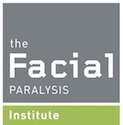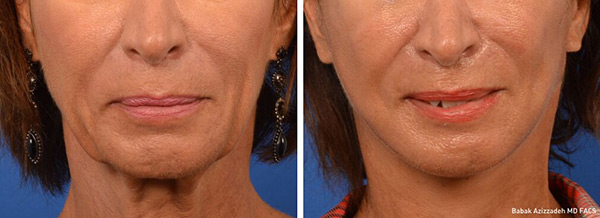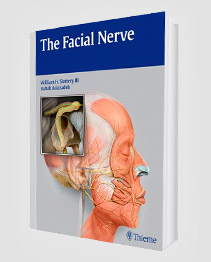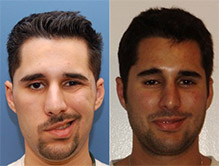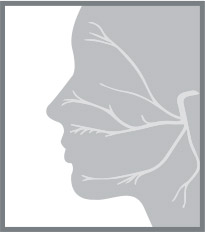At The Facial Paralysis Institute, we know how difficult a diagnosis treatment and surgery of Moebius syndrome can be for you or your child. Also called congenital oculofacial paralysis, this neurological condition causes facial weakness and paralysis. A congenital condition, it is present at birth, and it can pose many problems for the people who have it. Several nerves can be affected, including the sixth and seventh cranial nerves. If the seventh cranial nerve, known as the facial nerve, is involved, the person cannot make facial expressions. With congenital damage to the sixth cranial nerve, or the abducens, the afflicted eye cannot rotate outward, impeding normal vision.
Dr. Babak Azizzadeh is a Harvard-trained, double board-certified facial plastic and reconstructive surgeon who has changed the lives of many patients with this condition. Along with the rest of the team of world-renowned facial paralysis surgeons at the Facial Paralysis Institute, Dr. Azizzadeh can help patients with this syndrome gain facial movement for the first time. After surgery, patients will be able to make facial expressions and smile, as well as gain functionality in the eyelids.
The most common facial reanimation procedures for Moebius syndrome treatment and surgery include:
- Temporalis tendon transfer
- Bilateral gracilis muscle transfer to masseter nerve
- Bilateral selective neurolysis
- Eyelid reconstruction
Our team of world-renowned facial paralysis surgeons are here to provide Moebius syndrome treatment that gives patients new confidence and abilities. We know that every patient is unique. Because of this, we develop a customized treatment plan for every single patient, ensuring that they receive the best results possible. Moebius syndrome patients will undergo a thorough consultation with Dr. Babak Azizzadeh so he can evaluate the patient and determine the best Moebius syndrome treatment and surgery plan. Dr. Azizzadeh offers virtual consultations available for everyone to consult with the leading facial paralysis expert.
If you or your child are suffering from this syndrome, please call the Facial Paralysis Institute today at (310) 807-2829 to schedule your consultation with Dr. Azizzadeh.
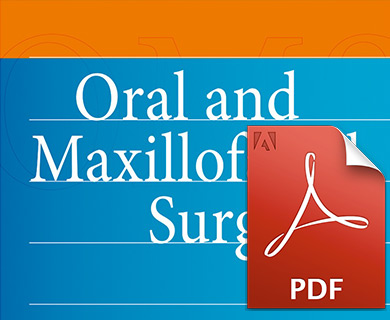
Examining the genetics of congenital facial paralysis — A closer look at Moebius syndrome
Download Dr. Azizzadeh’s article on Moebius Syndrome.
Moebius Syndrome
Moebius syndrome is a rare neurological condition that hampers a person’s ability to make facial expressions and control eye movement. It is commonly associated with facial paralysis or weakness of the facial muscles.
People born with Moebius syndrome often have a small chin, small mouth, and short tongue. They may also have an abnormal opening at the roof of the mouth. These issues may cause speech problems, along with missing or misaligned teeth.
Additionally, Moebius syndrome affects a person’s ability to make back-and-forth eye movements. It may make it difficult for a person to completely close his or her eyes when blinking or sleeping as well. This increases a patient’s risk of eye irritation and dryness.
Because it is present at birth, there are symptoms of Moebius syndrome that parents and caregivers can watch for. If a child experiences any of these symptoms at birth, a consultation with Dr. Azizzadeh at the Facial Paralysis Institute, can help parents map out a Moebius syndrome treatment and surgery plan.
- Facial weakness or paralysis affecting one or both sides of the face
- Paralysis inhibiting sideways eye movement
- Excessive drooling (a common sign with affected infants)
- Crossed eyes
- Infants that have difficulty suckling or eating
- Issues with swallowing
- Eyelids that do not fully close, noticeably during sleep
- Dry eye resulting in corneal ulcerations (open, red sores in the eyes)
Physical abnormalities such as cleft palate, webbed hands, missing fingers, and clubbed feet are not uncommon in children with this syndrome. Left untreated, the condition can cause additional issues. As children grow older, they may have speech delays. Some may experience intellectual disability or Autism spectrum disorder. Because of their inability to express emotions in a typical manner, individuals may grow frustrated and anxious about other peoples’ inaccurate perception of them, resulting in withdrawal from certain social situations.
Other patients may have difficulty eating and swallowing due to cleft palate and facial paralysis. At the Facial Paralysis Institute, our goal is to help patients gain some control over their facial features with our Moebius syndrome treatment and surgery plan, allowing them to feel confident in expressing who they are. We also make it our mission to restore as much function as possible when it comes to chewing, swallowing, closing the eyes, and other small but critical abilities that patients may lack.
How Is Moebius Syndrome Diagnosed?
Moebius syndrome is generally diagnosed based on two clinical criteria: the appearance of non-progressive congenital facial weakness and an inability to move one or both eyes away from the nose.
Research shows Moebius syndrome occurs in anywhere from two to 20 cases per million births. This syndrome also affects individuals of all ethnicities, and it has no gender bias.
What Causes Moebius Syndrome?
There is no surefire cause of Moebius syndrome. However, research indicates it may occur due to a combination of environmental and genetic factors. Some researchers have also discovered specific genes that may be related to congenital oculofacial paralysis. Taking certain medications or abusing drugs during pregnancy may also cause congenital oculofacial paralysis.
Is Moebius Syndrome Genetic?
Most cases of congenital oculofacial paralysis are sporadic, and as such, they occur in people with no family history of the disorder. Researchers continue to study this syndrome to determine if genetics are the primary cause for the condition. To date, researchers have found changes in certain genes may cause Moebius syndrome. But there is still no proof that it is a genetic condition, and there is no certain answer for what causes Moebius syndrome.
Candidates for Moebius Syndrome Treatment
Moebius syndrome treatment and surgery is usually performed on children before or shortly after they enter school. Dr. Azizzadeh and the team of experts at the Facial Paralysis Institute understand that each patient has a unique presentation of the condition, which means treatment is specifically tailored to the patient.
It is not only children that Dr. Azizzadeh performs this surgery on. Dr. Azizzadeh can treat children, teenagers, or adults with congenital facial paralysis as well.
Dr. Azizzadeh allocates significant time and resources to learn about each Moebius syndrome patient who enters his office. He studies their unique facial paralysis symptoms, asks them what their goals are for surgery, and then develops a personalized Moebius syndrome treatment and surgery plan. By doing so, Dr. Azizzadeh ensures a patient can achieve the best possible treatment results.
Moebius Syndrome Treatments
Many congenital oculofacial paralysis patients are unable to smile, frown, or make lateral eye movements. As a result, treatments are designed to help patients improve facial reanimation. Surgical treatments are commonly paired with physical and speech therapy, ophthalmology treatment, and therapy provided by additional medical specialists who can help patients gain muscle strength and other crucial skills. We will explore some of the most common Moebius syndrome treatment and surgery we perform at the Facial Paralysis Institute.
TRIGEMINAL-GRACILIS MUSCLE TRANSFER
For facial paralysis on both sides of the face, the surgeons at the Facial Paralysis Institute use microsurgical trigeminal-gracilis muscle transfer.
This procedure involves transfer of the gracilis muscle (from the inner thigh) to the face and attachment to the trigeminal nerve, which controls the muscles for chewing. The gracilis muscle and nerve transfer allows children to control the movement of the face voluntarily. For this treatment option, each side of the face must be treated in separate stages. Typically, the first operation is performed when the child turns 6. The second stage is then performed at age 7.
Temporalis Tendon Transfer
The temporalis muscle is one of the muscles that we use for chewing. It is one of the strongest and most dynamic muscles in the body. The trigeminal nerve, or the fifth cranial nerve, is responsible for its activity. Since this nerve is generally unaffected by Moebius syndrome, we can use this muscle to achieve facial reanimation.
During the procedure, Dr. Azizzadeh makes a tiny incision around the laugh lines of the mouth to locate the temporalis tendon, and then he rotates the tendon of the temporalis muscle over and attaches it to the corner of the mouth. When the patient bites down, the face naturally moves. This temporalis transfer procedure has been a very successful Moebius syndrome treatment and surgery procedure in rehabilitating dynamic facial movement and creating facial symmetry for patients with congenital oculofacial paralysis.
Bilateral Gracilis Muscle Transfer to Masseter Nerve
For the majority of patients with Moebius syndrome, their native facial muscles are not functional. Therefore, the gracilis muscle (located in the inner thigh) needs to be used to help generate spontaneous facial movement. The gracilis muscle is unique in that it can be harvested along with its nerve, artery, and vein and transferred to the face. Using Moebius syndrome microsurgical techniques, Dr. Azizzadeh from the Facial Paralysis Institute will take a small portion of gracilis muscle from each inner thigh, transfer the muscles to both sides of the patient’s face, and attach the gracilis muscles to the masseter nerves.
The masseter nerve (originating from the fifth cranial nerve) is responsible for activating the muscles used to chew. Therefore, when connected to the gracilis muscles, it supports dynamic facial animation. Over the next 6 to 9 months, the muscles activate and the patient achieves a symmetrical smile and strong facial movement capabilities. The strength and control of the reconstructed smile continues to improve over the next few years with the help of Moebius syndrome treatment and surgery.
Bilateral Selective Neurolysis
The most cutting-edge advancement in facial paralysis surgery is bilateral selective neurolysis, which provides spontaneous animation of the face. Pioneered by Dr. Azizzadeh from the Facial Paralysis Institute, selective neurolysis is an intricate operation, but the downtime and risks involved for the patient are minimal. The procedure involves releasing the platysma muscles (which pull the corners of the mouth down, hence preventing upward smile motion) and selectively decreasing the activity of the nerves that counter the smile mechanism to help get an upward trajectory of the mouth. These Moebius syndrome treatment and surgery procedures allow spontaneous reanimation of the face. Selective neurolysis is also a phenomenal treatment for patients with unilateral or bilateral Bell’s palsy.
Eyelid Reconstruction
Individuals with Moebius syndrome may suffer from strabismus (crossed eyes) or eyelid closure issues, which can cause dry eye and corneal ulcers. Together, Dr. Azizzadeh and the surgeons on his team can perform a number of procedures to reconstruct the eyes and eyelids, including but not limited to:
- Strabismus surgery, which involves detaching and reattaching eye muscles to correct crossed eyes
- Gold weight implants to weigh eyelids down just enough so that they close completely
- Platinum chains to help weigh down the eyelids
- Eyelid springs
- Minimally invasive, orbicularis-sparing (MIOS) lower eyelid recession
The goal of eyelid reconstruction procedures is to improve vision and tighten eyelid muscles to allow for easier closure while still maintaining a natural and symmetrical appearance.
For more information about Moebius syndrome, please visit The Moebius Syndrome Foundation’s website.
Why Choose Dr. Azizzadeh For Your Moebius Syndrome Surgery?
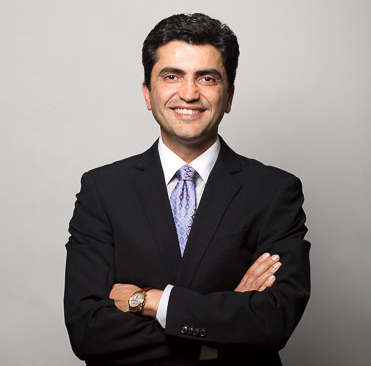
In order to ensure that patients are receiving the safest and most effective care possible, it is crucial to choose a surgeon with years of experience and expertise like Dr. Azizzadeh. Babak Azizzadeh, MD, FACS, is a world-renowned facial plastic & reconstructive surgeon who is deeply committed to the treatment of individuals with facial paralysis and Moebius syndrome. He is double board-certified by the American Board of Facial Plastic & Reconstructive Surgery and the American Board of Otolaryngology-Head & Neck Surgery.
Additionally, Dr. Azizzadeh completed a prestigious fellowship focusing on facial nerve anatomy and reconstruction at Harvard Medical School that provided him with an unparalleled knowledge of facial aesthetics and underlying facial anatomy. As a pioneer in his field, Dr. Azizzadeh is the author of the preeminent textbook, “The Facial Nerve,” and has contributed to hundreds of peer-reviewed articles.
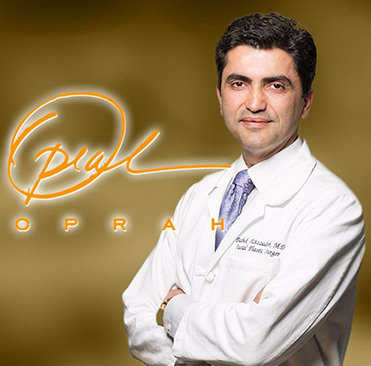
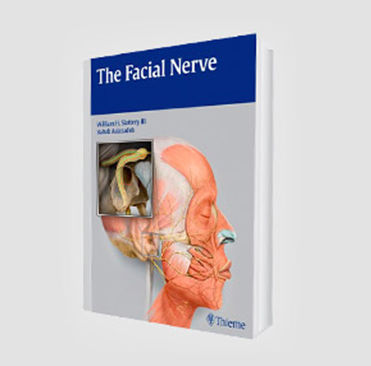
As the primary surgeon involved in Mary Jo Buttafuoco’s miraculous facial reanimation surgery following a devastating gunshot wound to the face, Dr. Azizzadeh was a featured guest on The Oprah Winfrey Show. He is the only facial nerve specialist to be featured on the show. Additionally, Dr. Azizzadeh has been asked to contribute to The New York Times, People magazine, Discovery Health, and The Doctors television show, among others, for his distinct expertise in the field.
In addition to his surgical practice, Dr. Azizzadeh is active in several different humanitarian causes. These include the Global Smile Foundation, which provides medical care to cleft palate patients in underserved areas around the world, and the Facial Paralysis & Bell’s Palsy Foundation, which he founded in 2009.
F.A.Q. About Moebius Syndrome
Which nerves are involved in Moebius syndrome?
Congenital oculofacial paralysis occurs due to underdeveloped sixth and seventh cranial nerves. If these nerves do not fully develop, they may cause unilateral (one side of the face) or bilateral (both sides of the face) facial paralysis. In some instances, other cranial nerves may be involved in Moebius syndrome as well. These include the third, fourth, fifth, ninth, 10th, and 12th cranial nerves, which control the ability to move the eyes, taste, swallow, digest, regulate the heart rate, and move the tongue.
Is Moebius syndrome hereditary? If so, is Moebius syndrome dominant or recessive?
Moebius syndrome can be inherited, and in these instances, it occurs as autosomal dominant, autosomal recessive, or sex-linked. However, most cases are sporadic. Moebius syndrome often occurs once in a family, and it has a low chance of occurring in another pregnancy.
Can Moebius syndrome be detected before birth?
Moebius syndrome cannot be detected before birth. A clinical examination is required after birth for a child to receive a proper diagnosis.
Are other health problems associated with Moebius syndrome?
Patients sometimes experience clubfoot or missing or webbed fingers. Meanwhile, children with Moebius syndrome may be more likely than others to experience low or poor muscle tone, especially in the upper body. This lack of muscle tone may make it difficult for children to sit, crawl, and walk.
Can Moebius syndrome be cured?
There is no cure for this condition, but treatments are available to help patients improve facial reanimation. The treatment that works well for one patient may not work well for another. Thus, it is important for patients to undergo a clinical examination to determine the best course of action to treat facial paralysis symptoms.
SCHEDULE YOUR MOEBIUS SYNDROME SURGERY CONSULTATION TODAY!
Moebius syndrome is a rare neurological disorder that can be difficult to identify and address. Dr. Azizzadeh, a globally recognized facial plastic and reconstructive surgeon, has unique expertise in both facial plastic and reconstructive surgery and head and neck surgery (otolaryngology). He treats Moebius syndrome patients and helps these individuals alleviate their facial paralysis symptoms.
To learn which one of these surgery options is best for you, schedule your consultation with Dr. Azizzadeh today. At the Facial Paralysis Institute, our primary objective is to provide patients with leading-edge surgical treatments in a warm and compassionate environment.
Sources:
https://rarediseases.org/rare-diseases/moebius-syndrome/
https://my.clevelandclinic.org/health/body/21998-cranial-nerves
Request your consultation with Dr. Azizzadeh today
Call us at (310) 657-2203 to schedule an appointment.
Schedule a Consultation